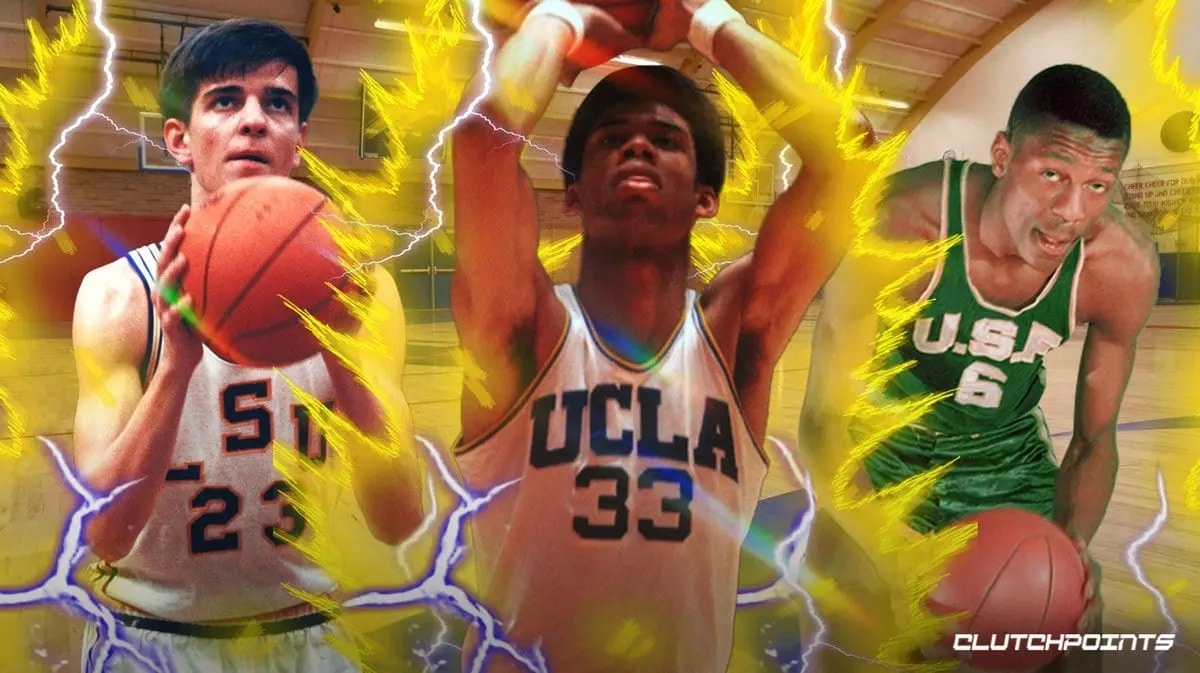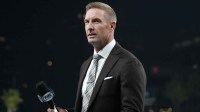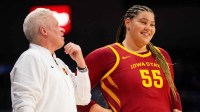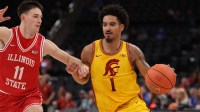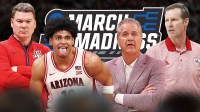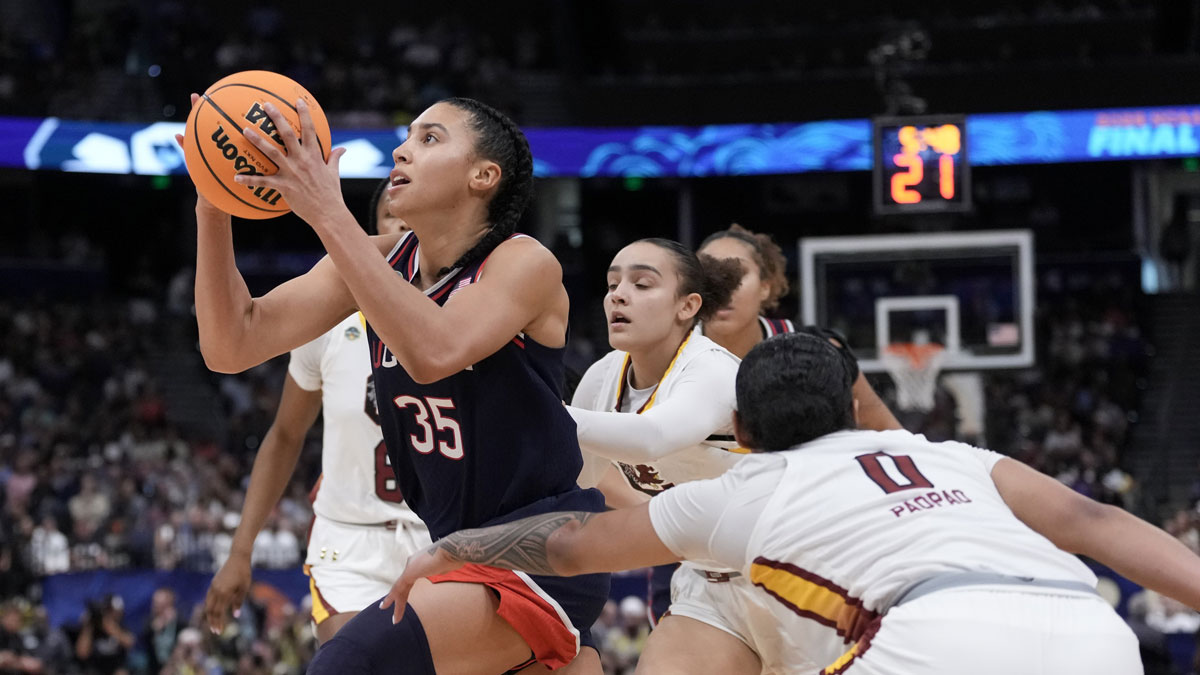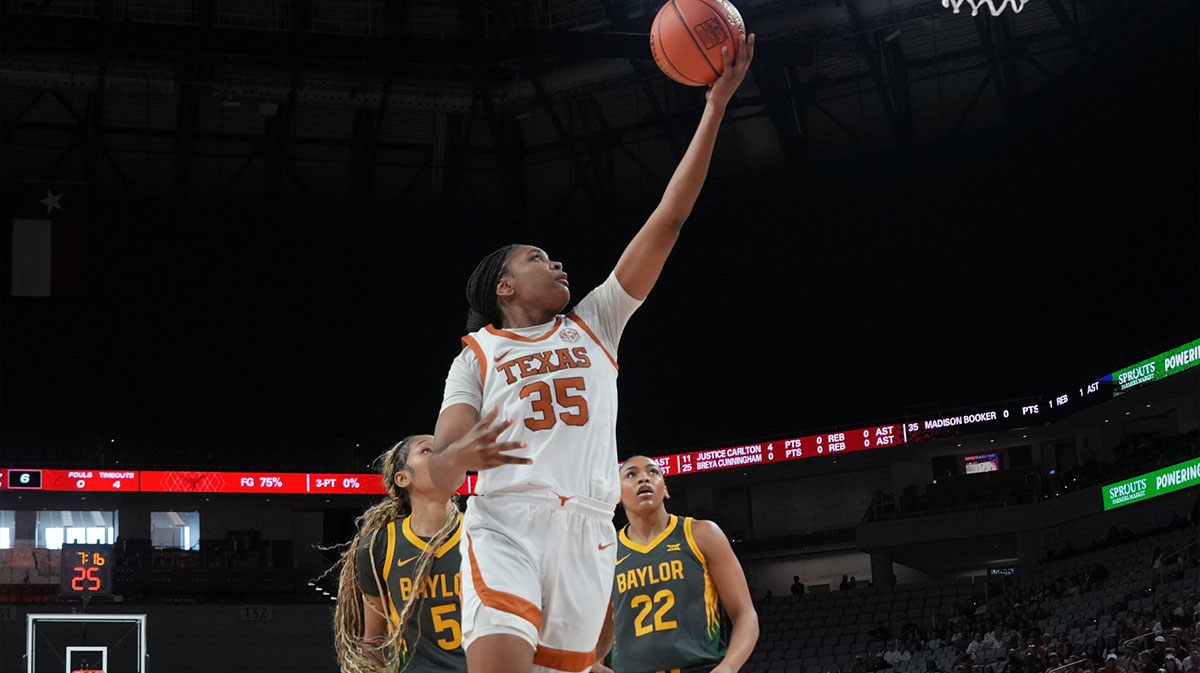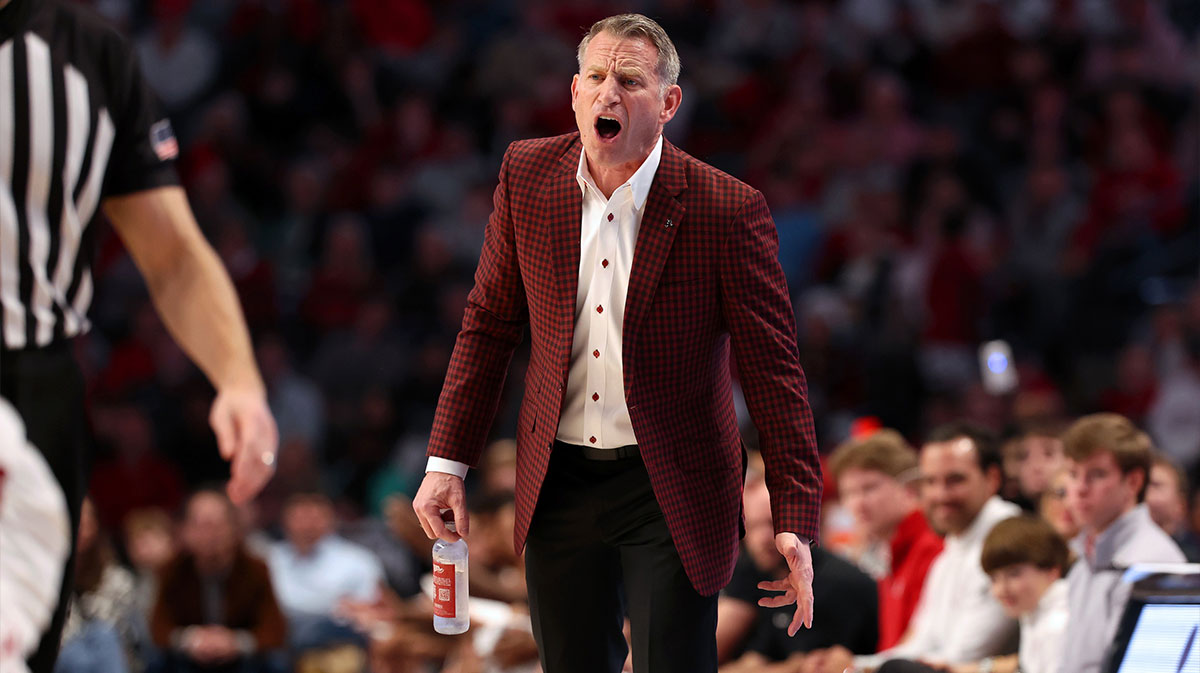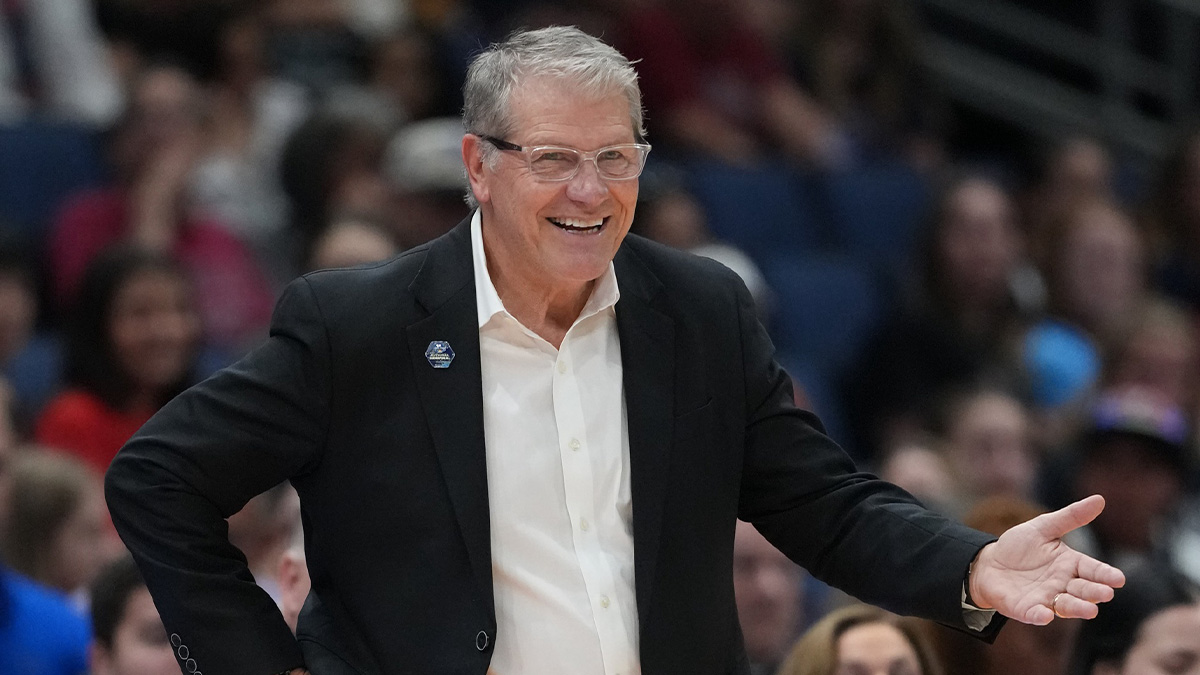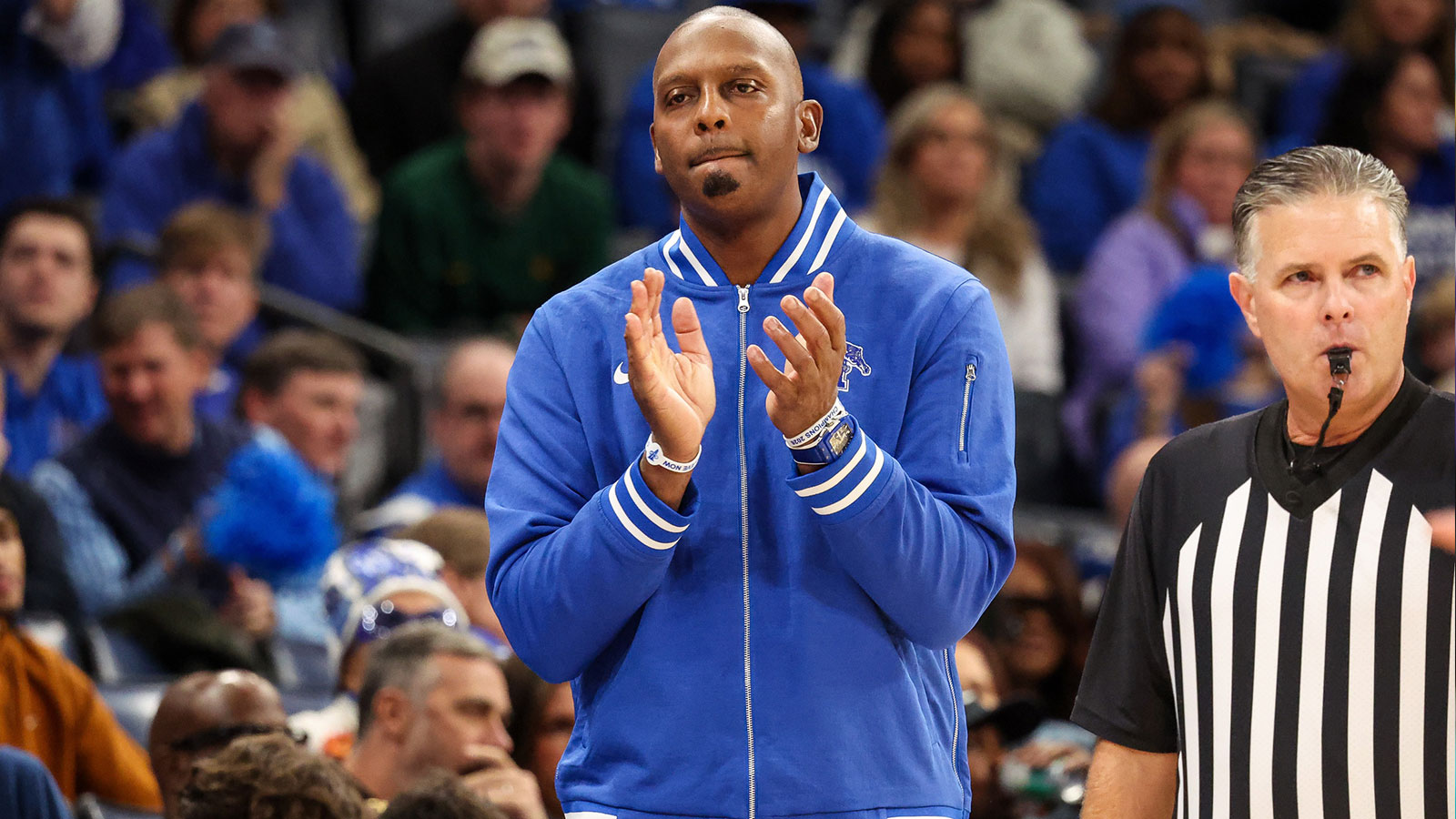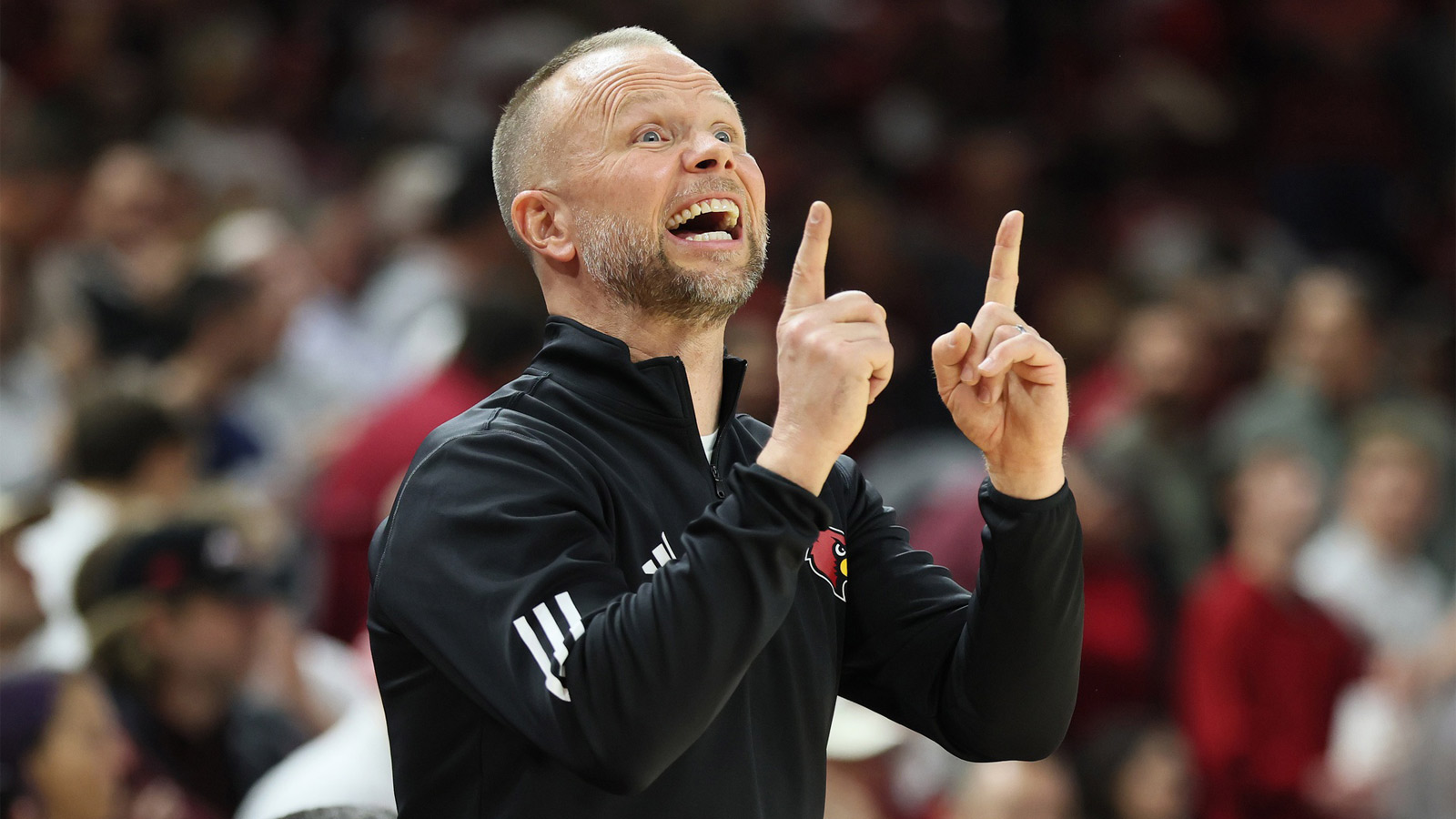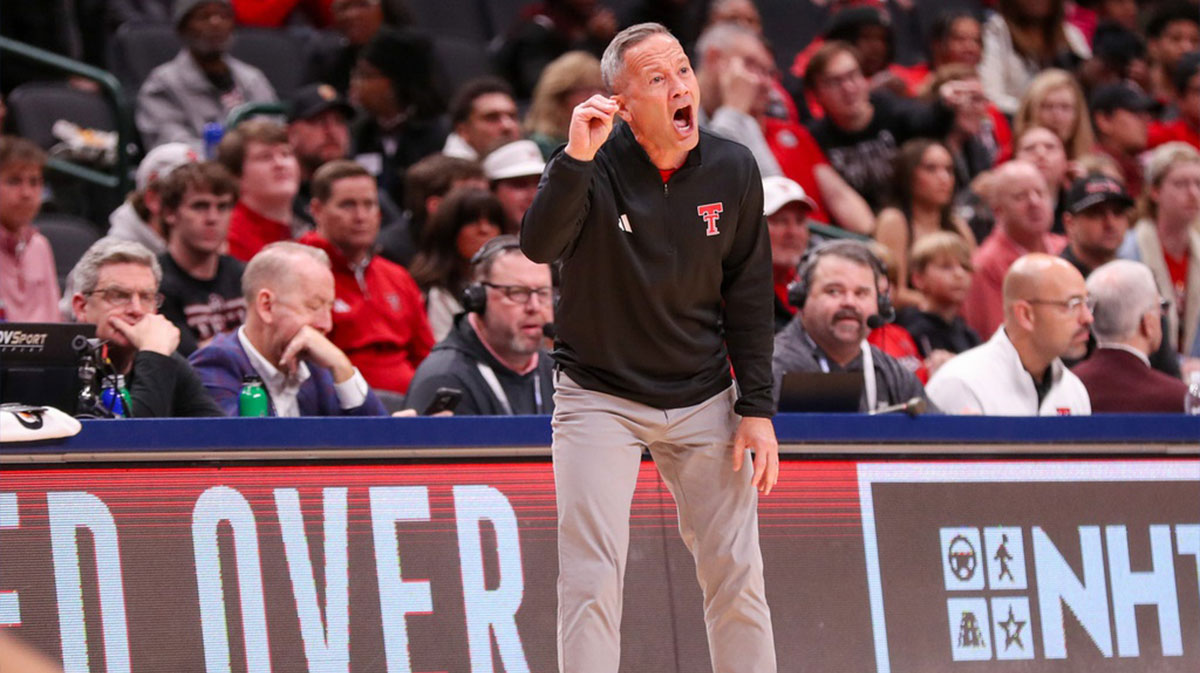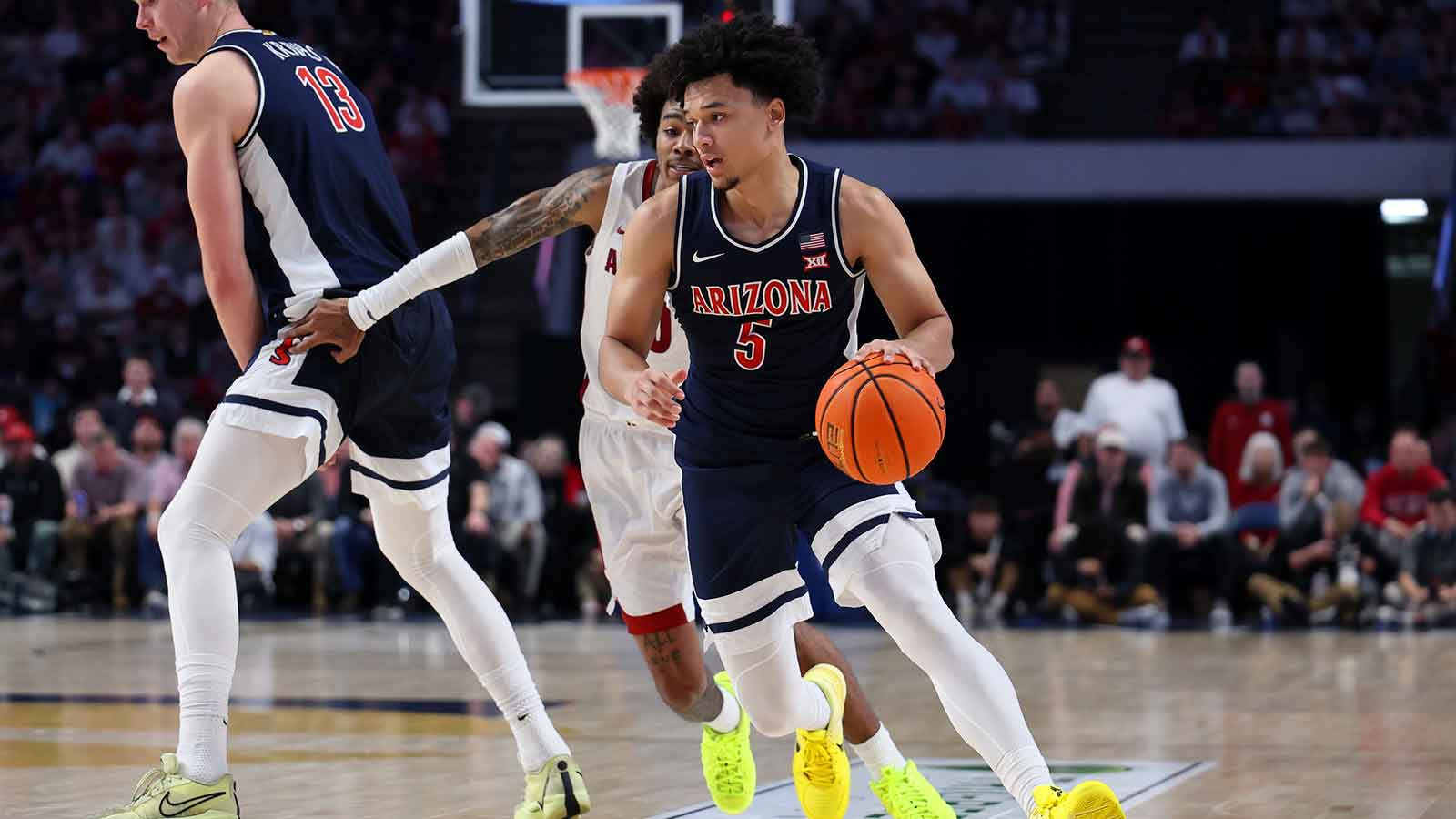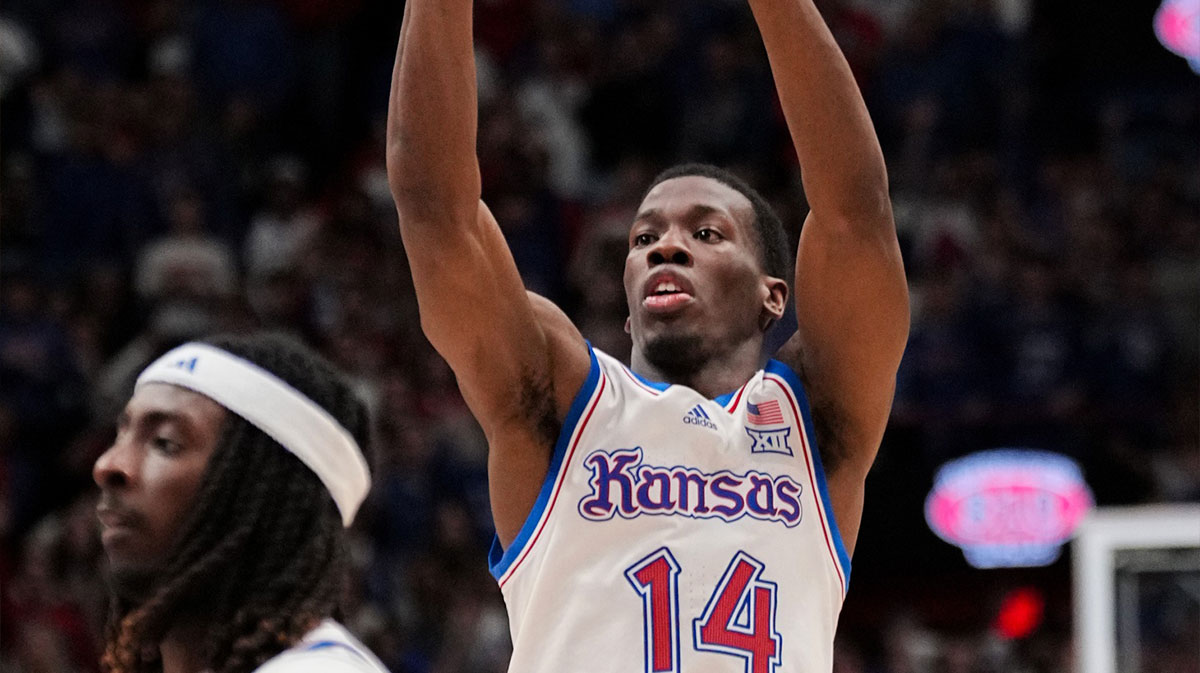As the 2025 Final Four approaches, there is no better time than now to rank the 25 greatest college basketball players of all time. Whenever doing such a challenging task like ranking the best college basketball players ever, many things need to be taken into account, but more on that in a second.
College basketball is littered with remarkable young athletes who suit up for various schools to try and climb the amateur ranks, attempting to place their mark in history along the way. Some of these student-athletes provided their schools with some of the best basketball years in their programs history, amassing various individual achievements along the way.
Many factors will be taken into account. Individual achievements, such as National Player of the Year awards and All-Tournament First through Third Team honors, will of course strengthen a player's bid to be considered as one of the best. The same can also be said for a player's individual statistics.
However, also being considered is the number of championships the player has won with their school, and the number of years that player gave to their program. Subjective considerations will also be taken into account, such as a player's impact on their college program. For example, a player like Doug McDermott, who stayed for all four years with Creighton while averaging around 21 points per game and winning a smattering of individual awards, would be higher up in the college basketball tier list than someone like Zion Williamson, who only spent one year in Duke but had an incredible freshman season.
Unfortunately, it is rare for great players to stick around for the entirety of their collegiate eligibility these days. Most great college basketball players in this era leave for the professional ranks after one year. Additionally, NIL and the transfer portal have changed the college landscape as well. That means the vast majority of great college basketball players are old-school players.
25. Doug McDermott: Creighton, 2010-14
College Averages: 21.7 points, 1.3 assists, 7.5 rebounds
Awards: Consensus National College Player of the Year, 2x Lute Olson National Player of the Year Award, 2x MVC Player of the Year, Big East Player of the Year, 2x MVC Tournament Most Valuable Player, 3x Consensus First Team All-American, 3x First Team All-MVC, First Team All-MVC, NCAA Scoring Champion
In this era of one-and-done college players it is tougher to find players like Doug McBuckets. Throughout four years at Creighton, McDermott established himself as the Bluejays' best player in their history. He set numerous school records, including the records for season points total (934 points), total made field goals in a season (330 field goals made) and season field goal percentage from three (49.0%).
His best season would come in his senior year, wherein he relinquished his scholarship and played as a walk-on. He averaged a career and nation-high 26.7 points on his way to winning the Consensus National Player of the Year. Unfortunately, the Bluejays never got past the third round of the NCAA Tournament with McDermott as their best player, reaching that stage three straight times. These third-round exits would still be their best finishes since the 1974 NCAA Tournament. By the end of his tenure at Creighton, McDermott would rank 5th all-time in career points in the NCAA with 3,150 total points, ahead of the likes of Oscar Robertson, Danny Manning, and Larry Bird.
McDermott was scintillating from beyond the arc in his stint with the Bluejays. He never shot below 40.5% from three in college, even shooting almost 50% from beyond the arc in his junior year. These percentages are particularly impressive, considering the volume of threes that he consistently put up.
Undoubtedly the NCAA's most recent great, he is the first college basketball player in 29 years to be named AP Player of the Year three times. He is also one of only three players in college basketball history to attain 3,000 points and 1,000 rebounds, the other two being Mike Daum and Lionel Simmons. These records, along with his numerous accolades, and most importantly, his incredible impact on today's NCAA, puts him at the pinnacle of college basketball greats. Another modern era player, Zach Edey, had a case for this final spot, after being named the National College Basketball Player of the Year in back-to-back seasons in 2023 and 2024.
24. Ralph Sampson: Virginia, 1979-83
College Averages: 16.9 points, 1.2 assists, 11.4 rebounds
Awards: 3x National College Player of the Year, 3x ACC Player of the Year, ACC Rookie of the Year, 3x Consensus First Team All-American, 3x First Team All-ACC
Ralph Sampson was a very sought-after prospect in his AAU days. It can easily be seen why; he was already 7'1″ even before reaching college, and he was averaging nearly a 30-20 stat line in his senior year for Harrisonburg High.
Sampson would not disappoint. He would lead the University of Virginia Cavaliers to three straight NCAA Tournament appearances, only failing to make the tournament in his freshman year. Even then, he led them to an NIT title, while putting up about 15 points and 11 rebounds. They would reach the Final Four next year, with Sampson averaging 17.7 points and 11.5 rebounds. They would lose to the UNC Tar Heels with Al Wood and James Worthy.
In Sampson's junior year, they would lose in the regional semifinal by only 2 points against Alabama-Birmingham, in a season wherein Sampson put up lower stats of 15.8 PPG and 11.4 RPG. He and the Cavaliers would bounce back nicely in his final season, with Sampson putting up career-best numbers of 19 PPG and 11.7 RPG on the way to an Elite Eight appearance, wherein they would lose by only 3 to NC State.
Besides Bill Walton, Ralph Sampson is the only athlete to win the Naismith Player of the Year three times. It was a blessing in disguise when he decided to not declare for the 1982 NBA draft (his junior year). The 7'4″ center is a gigantic legend in NCAA history, in every sense of the word.
23. Tim Duncan: Wake Forest, 1993-97
College Averages: 16.5 points, 12.3 rebounds, 2.3 assists
Awards: Consensus National College Player of the Year, 2x ACC Player of the Year, Chip Hilton Player of the Year, 2x Consensus First Team All-American, 3x First Team All-ACC, 3x NABC Defensive Player of the Year, NCAA Rebounding Champion
Coming out of high school, the Virgin Islands-born Tim Duncan was not the most well-known prospect. He was actually a competitive swimmer before starting to play basketball in St. Dunstan's Episcopal High School. Despite this, he turned out to be one of the best players in the Atlantic Coast Conference's history.
Tim Duncan was an absolutely solid player on both ends of the floor for Wake Forest in his four seasons there. Offensively, he never shot below 53% for his career. He also increased his scoring every year; he averaged under 10 points in his freshman season, then 16.8 his sophomore year, 19.1 the next season, and finally 20.8 in his last year, while also shooting more than 60% from the field. His rebounding was also incredibly impressive. He averaged at least 12 rebounds per game every year after his freshman season and lead the entire NCAA in rebounds in his final playing year with 14.7 RPG. His steady improvement can be taken as a lesson for players in this era to show how you can develop in college and still have a lengthy and impressive NBA career.
The Demon Deacons reached the NCAA Tournament every year that Duncan was on the roster, although never going past the ACC Tournament Final. In 11 NCAA Tournament games, he averaged almost 18 points and 15 boards, getting a double-double stat line in 10 of those games. A lot of his best games came in the tournament as well, such as a 22 point, 22 rebound game against St. Mary's, and a 16 point, 13 rebound, and 8 block outing against Charleston.
“The Big Fundamental” was aptly named, for his game was simple but efficient and effective. He was excellent under the basket, of course, but he had a mid-range game as well. He even had an outside shot, something he would develop and utilize further in the latter stages of his professional career.
Additionally, he is one of the best rebounders that the NCAA has ever seen, leading the tournament in rebounds per game for two years (1995 and 1996) and total rebounds once (1996) with 52. He is also second all-time in NCAA history for career double-doubles with 87. For most of his college career, however, he was more well-known for his defense. He was an excellent rim protector, consistently blocking “five or more shots” every game. Remarkable for a prospect who started playing ball about three or four years before college.
22. Bill Bradley: Princeton, 1962-65
College Averages: 30.2 points, 12.1 rebounds
Awards: USBWA College Player of the Year, Helms Foundation College Player of the Year, AP College Player of the Year, 2x Sporting News Player of the Year, UPI College Player of the Year, NCAA Final Four Most Outstanding Player, 2x Consensus First Team All-American
The best player in Ivy League history, and the conference's only player in this list, Bill Bradley was sensational in college, before he was a pro player and a U.S. Senator.
Choosing to play at Princeton despite initially choosing to play for Duke, Bradley averaged 27.3 points and 12.2 rebounds in his first playing year. He led the Tigers to an NCAA berth, losing to the St. Joseph's Hawks by only 1 point in the first round, with Bradley scoring 40 points.
Next season would be Bradley's best, averaging career-highs of 32.3 points and 12.4 rebounds on the way to getting First Team-All-American honors, as well as Sporting News' Player of the Year. Princeton would make it all the way to the regional semifinals, wherein they would be defeated by the UConn Huskies.
They would reach the Final Four in Bradley's final season, wherein he averaged 30.5 points and 11.8 boards. They would be felled by the Michigan Spartans in the national semifinals, and would ultimately fall to third place in the NCAA tournament.
Bradley holds several Ivy League records, such as both records for career points (1,253), points per game (29.3), and free throws made (409), among others. Coaches say he would've been more statistically impressive if not for his pass-first game. The small forward was one of the game's first great wings and is one of the best forgotten players in NCAA history.
21. Dan Issel: Kentucky, 1967-70
College Averages: 25.8 points, 1.2 assists, 12.9 rebounds
Awards: Consensus First Team All-American, Consensus Second Team All-American
Dan Issel is one of college basketball history's most prolific scorers. He showed his elite ability to put the ball in the net all throughout his three years in college, improving his scoring year after year after year in remarkably large increments.
The 6'9″ center averaged 16.4 points in his first playing year. It was said that his teammates neglected to pass him the ball in the early stages of his collegiate career.
He improved his scoring drastically in his junior year, increasing his points per game to 26.6 points, more than 10 points higher than the previous season. He pulled down 13.6 rebounds per game this year as well, an increase from last year's 12.1. The Wildcats would however lose in the regional semifinals against Marquette this season, a worse finish than last season's regional final defeat against the Ohio State Buckeyes.
The next season, Issel would show his brilliant best in a Wildcats jersey, averaging 33.9 points – an even better 13.3-point increase – on the way to getting First Team All-American honors, also an improvement from his Second Team All-American finish last season. The Wildcats would reach the regional final once again, wherein they were felled by Artis Gilmore's Jacksonville Dolphins.
Kentucky basketball's record books have been dominated by Dan Issel. He used to hold the records for single-game points and career made field goals, among others. Some of his all-time school records that are yet to be broken would be the Wildcat's all-time leader in career rebounds (1,077) and the single-season record for field goals made (369). Most notably, he still holds the record for career total points scored by a Wildcat with 2,138, as Coach Rupp predicted.
20. Austin Carr: Notre Dame, 1968-71
College Averages: 34.6 points, 7.3 rebounds
Awards: Naismith College Player of the Year, AP Player of the Year, Helms Foundation Player of the Year, UPI Player of the Year, Consensus First Team All-American, Consensus Second Team All-American
In this list of the greatest basketball players in NCAA history, Austin Carr's scoring average of 34.6 is second only to one; Pete Maravich. This says a lot about Carr's offensive greatness, but also about the overwhelming overall quality of the players in this list.
The man who would go on to be known as “Mr. Cavalier” came into the Notre Dame Fighting Irish program as an established scorer already. He averaged 22.1 points in his first playing year. This large scoring average would actually be Carr's lowest scoring collegiate season, since he would score 16 more points per game the next year, averaging 38.1 points to go along with 8.3 rebounds. Carr would finish his NCAA career averaging 38 points and 7 rebounds in his senior year. In his three years, the Fighting Irish made the NCAA Tournament every year, losing in the first round once and the regional semifinal two times.
Carr left several NCAA scoring records in his wake. His greatest all-time record would be his 44.3 points per game in all of his NCAA Tournament games the all-time record for points per game in all NCAA Tournament appearances. These feats made him one of the greatest March Madness players in history.
Austin Carr will always be known for being one of the greatest scorers of the ball in college basketball history; his scoring averages and all-time records could trump almost anyone in this list.
19. Lionel Simmons: La Salle, 1986-90
College Averages: 24.6 points, 2.7 assists, 10.9 rebounds
Awards: National College Player of the Year, 3x MAAC Player of the Year, Consensus First Team All-American, Consensus Second Team All-American, UPI Third Team All-American
Make no mistake about it: Lionel Simmons was one of the greatest scorers in college basketball history. It is rather unfortunate that he is not as universally well-remembered as a lot of the other players on this list. Perhaps this is due to his lack of NCAA Championships, or his rather short professional career. However, he will always be recognized in La Salle and Philadelphia as one of their greatest-ever players.
Lionel Simmons had a statistically incredible NCAA career for the Explorers. He is one of only three players in the 3,000 point,1,000 rebound club in the NCAA, with a total of 3, 217 points and 1,429 rebounds. He is also fifth all-time in career scoring. Simmons also holds numerous all-time records for La Salle, such as career PPG with 24.6, PPG in 1 season with 28.4, and the most points scored in 1 season with 908, among others.
Along with this, he led the Explorers to three consecutive NCAA Tournament berths, only missing one in his freshman season. They would lose in the first round of the tournament in his sophomore year against Danny Manning's Kansas Jayhawks, and again in his junior year against Louisiana Tech.
The Explorers would have their best season with Simmons in his senior year, with them having an all-time single season school record of 30-2, complete with a 22-game winning streak. Simmons would also win the National College Player of the Year this season. They would go one step further in the NCAA Tournament, winning in the first round against the Southern Miss, but would ultimately fall to the Clemson Tigers in the second round.
The achievements of L-Train, as well as his numerous all-time records both for the La Salle Explorers and the NCAA altogether, will make sure that his stamp in college basketball history will never fade.
18. Michael Jordan: North Carolina, 1981-84
College Averages: 17.7 points, 1.8 assists, 5.0 rebounds
Awards: NCAA Champion, Consensus National College Player of the Year, ACC Player of the Year, ACC Rookie of the Year, 2x Consensus First Team All-American, 2x First Team All-ACC
Before he was the best NBA players of all time, Michael Jordan had a college stint to remember, playing for the North Carolina Tar Heels for three years.
Coming out of high school, he was only ranked fourth in the country, below the likes of Adrian Branch, Stuart Gray, and Bobby Lee Hurt. He only averaged around 14 points and 4 rebounds in his freshman year, not the most eye-popping numbers. However, he did win the NCAA Championship that same year, putting up 16 points, 2 assists, (a team high) 9 rebounds, and 2 steals against Patrick Ewing's Georgetown.
Most importantly, he sank the game-winning shot in that game with 15 seconds remaining. It was one of the most memorable college basketball moments ever. It was, however, teammate James Worthy who led the Tar Heels with 28 points. Most of Jordan's individual accomplishments in college would come the two years after his freshman season, although he was named ACC Rookie of the Year that season as well. He set the record for most points scored by a sophomore in Tar Heels history with 721, before winning the Naismith and Wooden Player of the Year awards in his junior year. He also led his team in scoring for both years.
Even in college, people could see Jordan's immense potential. His play style drew praise from several news outlets. His offensive game was said to be flawless, from his inside passing to his driving ability to his formidable jump shot. He was very efficient on offense, shooting 50% from the field for his entire college career. There was something to be said even for his outside shooting, despite people claiming it to be a weaker aspect of his game; he shot an impressive 45% from beyond the arc in his collegiate career.
Most notably, he had a knack for coming up in the big occasion. The epitome of this would obviously be his championship-winning shot against Georgetown as a freshman, but there was also his 24-foot leveler against Tulane, whom they defeated in triple OT to prevent a 0-4 start to their season (Jordan's sophomore season). MJ would also come up big against Duke in his junior year, putting up 25 points to lead his team to victory against the Blue Devils to secure an undefeated regular season run.
MJ's collegiate career tends to be somewhat brushed aside, but he showed his GOAT potential even while he was at North Carolina. His spectacular offensive prowess and defensive doggedness, even in college, led to his smattering of individual awards. Not to mention, he displayed the clutch gene, which generated a ton of memorable moments. His NCAA Championship as a freshman starter ultimately just adds to his case as one of the best collegiate players in history.
17. Jerry West: West Virginia, 1957-60
College Averages: 24.8 points, 2.8 assists, 13.3 rebounds,
Awards: NCAA Final Four Most Outstanding Player, 2x SoCon Player of the Year, 2x Consensus First Team All-American, Third Team All-American
Coming out of high school, Jerry West had around 60 offers from different colleges nationwide. He chose to stay close to home and attend West Virginia University, with whom he would have a legendary collegiate career.
With West leading the way for the Mountaineers, they would not lose more than 5 games in each of his playing years. In his first season, he averaged 17.8 points and an impressive 11.1 rebounds as a 6'2” 2-guard. They would unfortunately get eliminated in the first round of the NCAA Tournament (a fourth straight time for the Mountaineers).
West would have a remarkable bounce-back season in his junior year, wherein his averages took a significant jump to 26.6 points and 12.3 rebounds. He would also tie the NCAA Tournament's five-game total scoring record of 160 points. He carried his team all the way to their very first National Championship, wherein they lost to the University of California by only one point. In the tournament, he led his team and their opponents in scoring and rebounding in every game including the Championship, wherein he put up 26 points and 11 rebounds.
His best statistical season would come in his senior year, wherein he put up averages of 29.3 points, 16.5 rebounds, and 4.2 assists, all career-highs. He also had an incredible 40 point, 16 rebound game against Virginia in the regular season, his best collegiate game. This is saying something, since he put up 30 triple-doubles and 15 30-point games in this stretch. They would lose in the regional semifinal against NYU, again by one point.
Jerry West was an offensive marvel for the Mountaineers. He could score from long-range and at the rim. He was very crafty in the paint as well, leading to him getting a lot of free-throw attempts. In fact, he holds the all-time record for the most free throw attempts in a single NCAA tournament at 71. Moreover, he was great defensively.
His tremendous leaping ability allowed him to pull down boards at an incredible rate for a guard, as well as block shots so effectively that he was compared to the great Bill Russell himself. His incredible performances both ends of the floor led him to co-captaining the USA's 1960 Summer Olympic team with Oscar Robertson.
16. Artis Gilmore: Jacksonville, 1969-71
College Averages: 24.3 points, 22.7 points
Awards: Consensus First Team All-American, Second Team All-American, 2x Rebounding Champion
The Jacksonville Dolphins got a true gem when 20 year-old, 7'2″ center Artis Gilmore transferred to them from Gardner-Webb Junior College. At the North Carolina college, he averaged 22.5 points and 7 rebounds for two years. In his last two playing years spent in Florida, he outdid his Gardner-Webb performances with averages of 24.3 points and 22.7 rebounds.
By the time that Gilmore went to Jacksonville, they had only been participating in college ball for three seasons, having an overall record of 38 wins and 37 losses. In his first playing year (as a junior), Gilmore led the Dolphins to a 27-2 record, as well as their very first NCAA tournament berth.
On the way to the National Championship, Gilmore had an epic tournament run, averaging 28.3 points and 19.3 rebounds on the way. They would defeat the 22-3 Western Kentucky, the 20-5 University of Iowa, and the 26-2 Kentucky Wildcats led by Dan Issel, who was putting up almost 40 points and 18 rebounds at the time. They would then go on to defeat Bob Lanier's St. Bonaventure Bonnies on the way to the National Championship. The Dolphins would, however, run into coach John Wooden's UCLA, who were still in the midst of their NCAA dynasty at the time. They would lose to the Bruins, despite Gilmore putting up 19 and 16. They would again reach the NCAA Tournament next year, but would ultimately lose in the first round to Western Kentucky in the first round.
A-Train's 2-year NCAA run easily remains the best in Jacksonville Dolphins history, and one of the greatest in NCAA history. He is also part of an elite five-player club who averaged at least 20 points and 20 rebounds in their collegiate careers. Undoubtedly a statistical monster in his collegiate tenure.
15. Wilt Chamberlain: Kansas, 1956-58
College Averages: 29.9 points, 18.3 rebounds
Awards: NCAA Tournament Most Outstanding Player, 2x Consensus First Team All-American
Before the NBA, the University of Kansas Jayhawks got to witness firsthand the legend of Wilt Chamberlain.
Wilt the Stilt, in his two years in Kansas, posted all-time school record averages of 29.9 points and 18.3 rebounds, averaging more than 30 PPG in his final year. In his first playing year, he led the Jayhawks to a Big 7 championship, and as such, an NCAA Tournament berth.
There, he would reach the National Championship, wherein they would lose to the North Carolina Tar Heels. Chamberlain's route to the finals was not a pleasant one. He would routinely get triple-teamed whenever he received the ball, and almost every team would freeze the ball, which here means that they would pass the ball around without attempting to shoot it, possible due to the absence of the shot clock.
Among these tactics specifically targeted to stop Chamberlain, he and his team would routinely get incredibly harsh treatment from the fans of whichever team they played against. They would get pelted by garbage and assaulted with severe racist abuse; the team had to be escorted by police while exiting the arenas. Even so, Chamberlain played incredible basketball, having a 32 point, 11 rebound game in the semifinals, with 8 blocks. Teams had to employ the aforementioned tactics due to Chamberlain's dominance on both ends of the floor.
Besides Chamberlain's ridiculous athletic capabilities, he was also a gifted shot-blocker, and had an arsenal of offensive weapons that he would routinely go to. He did not just play under the basket; he also had a formidable fade-away jumper and bankshot that served to keep his defender(s) honest.
The Big Dipper (his favorite nickname) was an athletic spectacle in college. He did not just demonstrate this in basketball; rather, he also represented the University of Kansas in NCAA track-and-field events. He would win the high jump in his conference for three straight years. It is unfortunate that he decided to forego his final year of NCAA basketball, in that he could have very easily placed even higher in the NCAA basketball charts.
14. Danny Manning: Kansas, 1984-88
College Averages: 20.1 points, 2.3 assists, 8.1 rebounds
Awards: NCAA Champion, NCAA Final Four Most Outstanding Player, Naismith College Player of the Year, John R. Wooden Award, NABC Player of the Year, 3x Big 8 Player of the Year, 2x Consensus First Team All-American, Consensus Second Team All-American
Many people consider Wilt Chamberlain to be the outright best player to ever suit up for the Kansas University Jayhawks. However, it can be said that Danny Manning is KU's GREATEST ever player, arguably contributing more to their basketball program than even The Big Dipper.
Manning was Kansas Player of the Year prior to his freshman year. He got better and better all throughout his 4 years in college, coming to average almost 25 PPG in his senior year, from 14.6 PPG in his freshman year. The Jayhawks reached the NCAA Tournament for all of Manning's 4 years. They were knocked out in the second round in his freshman year, the Final Four in his sophomore year, and the regional semifinal in his junior year.
The Jayhawks would finally attain their 5th NCAA Championship in Manning's senior year, with him going off for a historic performance of 31 points, 18 rebounds, 5 steals, and 2 blocks against an Oklahoma Sooners team consisting of 3 future NBA 1st round picks. Add to this the fact that the Jayhawks had a record of 21-11 going into the NCAA tournament, which was the most losses for an eventual NCAA Championship team, their team moniker “Danny and the Miracles” was especially fitting and well-deserved.
One of the Big 8's greatest ever players, Manning ended up being the conference's all-time leader in total points with 2,455. He was also 2nd all-time in the Big 8 for career rebounds (now 5th all-time). Ultimately, Manning earned the title of Big 8 player of the decade, solidifying his Kansas University legacy, and with that, his college basketball legacy.
13. Larry Bird: Indiana State, 1976-79
College Averages: 30.3 points, 4.6 assists, 13.3 rebounds
Awards: National College Player of the Year, 2x MVC Player of the Year, 2x Consensus First Team All-American, Third Team All-American
Indiana State University basketball was a virtual unknown before a certain Larry Bird, and they haven't done a lot since his tenure there. They had never once made an NCAA tournament in their history. They were about the “third or fourth” best team in their own conference. By the time that Larry Bird had finished college, the Sycamores nearly had the most recent undefeated collegiate season, with Bird leading them to a 33-0 record en route to their very first NCAA Championship game.
All throughout his collegiate career, Larry Legend was well-known for his scoring, averaging 30.3 points in three seasons, while averaging a college career-high of 32.8 points in his first season. He crashed the boards as well, with a career average of 13.3 rebounds. In addition, he always had a “team-first” mentality, wherein the team's “first option” would be the open man.
Bird played in only one NCAA tournament in his collegiate career, but he was absolutely incredible in all five games. He had his best college game in the semifinal against DePaul, posting a stat line of 35-9-16, which were all NCAA career highs for him. He then went on to play in what would be the most watched college basketball game in NCAA history against Magic Johnson and the Michigan State Spartans. Bird and his Sycamores would ultimately lose the game, with him only shooting 33% from the field.
Considering where Indiana University were in terms of college basketball prominence, Larry Bird has undoubtedly left an exceptionally large mark on Sycamore basketball. The Hick from the French Lick is the undisputed best player to ever come out of Indiana State University, and it's not even close.
12. Earvin Johnson: Michigan State, 1977-79
College Averages: 17.1 points, 7.9 assists, 7.6 rebounds
Awards: NCAA Champion, NCAA Final Four Most Outstanding Player, Consensus First Team All-American, Second Team All-American, Third Team All-American
Everything about Earvin “Magic” Johnson oozed charisma. From his nickname to his million-dollar smile to his dynamic, all-around play style, fans were simply in awe of the huge point guard the minute he was launched into prominence.
The Michigan State Spartans knew at once what they were getting with Johnson, as he came out of Everett High School with a State Championship, averaging 28.8 points and 16.8 rebounds. He was big, quick, could handle the ball well, and could make jaw-dropping plays, particularly in transition. It was also in High School wherein he got his “Magic” moniker, after a 36-16-18 game as a sophomore.
He continued his unique style of play in Michigan State, choosing to play for the Spartans once he was assured that he could play the 1, his natural position. In truth, he could play all 5 positions; he was elite in almost every skill needed to play each position, save for outside shooting, which he did improve on throughout his collegiate career. His versatility is also highlighted in his box scores and averages, which can be seen above. Just as noticeable in Magic's collegiate tenure is his exceptional leadership, becoming the Spartans' talisman in his freshman year.
Johnson's collegiate career would peak in his sophomore year, wherein he bested Larry Bird's Indiana State Sycamores in the 1979 NCAA Championship. He would lead both teams in scoring with 24 points, with 5 assists and 7 rebounds, while keeping Bird at bay with 19 points on only 33% shooting. The Spartans would go on to win their very first NCAA Championship in this game.
Magic's contributions to Michigan State basketball and NCAA basketball in general puts him in the annals of college basketball history. His massive draw and captivating showmanship, along with his storied rivalry with Larry Bird, helped propel March Madness to the spectacle that it has come to be known today.
11. Tyler Hansbrough: North Carolina, 2005-09
College Averages: 20.2 points, 1.1 assists, 8.6 rebounds
Awards: NCAA Champion, Consensus National College Player of the Year, ACC Player of the Year, ACC Tournament Most Valuable Player, USBWA National Freshman of the Year, ACC Rookie of the Year, 3x Consensus First Team All-American, Consensus Second Team All-American, 4x First Team All-ACC, ACC All-Freshman Team
One only has to take a swift look at Tyler Hansbrough's massive college trophy cabinet to realize how great he was for the University of North Carolina Tar Heels. He is talked about as their greatest ever player, even better than a certain Michael Jordan.
Hansbrough made history as a rookie as the very first freshman to be given First Team All-American honors. He also became the very first rookie in Tar Heels history to lead the team in scoring and rebounding, and holds the record for the highest scoring average by a Tar Heels freshman at 18.9. In addition, he became the first-ever Tar Heel to lead his team in scoring, rebounding, steals, and field goal percentage in one season, only the 7th player in ACC history to do so. Furthermore, he set the all-time ACC freshman single-game scoring record with 40 against Georgia Tech. These went along with a smattering of rookie awards.
He went on to average 20.2 points and 8.6 rebounds in college, reaching the NCAA Tournament for all of his four playing years. They would lose in the second round in his rookie year, the regional finals in his sophomore year, and the Final Four in his junior year. Hansbrough would finally get his hands on the NCAA Championship on his Senior Year, defeating the Michigan State Spartans led by Kalin Lucas and a rookie Draymond Green.
Along with the individual awards, Hansbrough broke several records after his freshman year. These include setting the all-time NCAA record for most free throws made with 982, being the first player to earn All-America and All-ACC First Team honors in all 4 years in college, and setting a new all-time UNC record for most career points with 2,872, among others.
The most notable thing about Hansbrough's game was his unmatched effort on both ends of the floor. He would always be the most energetic player on the court, with an air of aggression about him. It would turn out that “Psycho T” was just what North Carolina State needed to reach the very top of the NCAA pyramid, and he did so while creating one of the most decorated CV's in college basketball history. Hansbrough is the greatest college basketball player of the 21st century.
10. Christian Laettner: Duke, 1988-92
College Averages: 16.6 points, 1.8 assists, 7.8 rebounds
Awards: 2x NCAA Champion, NCAA Final Four Most Outstanding Player, Consensus National College Player of the Year, ACC Player of the Year, 2x ACC Athlete of the Year, Consensus First Team All-American, Consensus Second Team All-American, 2x First Team All-ACC, Second Team All-ACC
Every single time that Christian Laettner steps on a collegiate court, the absolute hatred from opposition fans is palpable. He is widely regarded as one of the most hated players in college basketball history, and is considered to be the catalyst of the disdain for Duke Basketball and its players, most notably players like Grayson Allen and J.J. Redick. With this, he is also regarded as one of the greatest, winningest players in Blue Devil and NCAA history.
16.6 points and 7.8 rebounds aren't the most eye-popping stats, but his greatness in collegiate basketball comes from the toughness, grit, and swagger that he exuded every game, along with the trophies and individual awards. Laettner is best known for having the clutch gene, coming up big in important moments. He currently holds the record for most points scored in an NCAA tournament with 407, as well as the most games played in the tournament, with 23 out of a possible 24 games.
He also led the Blue Devils to win their very first NCAA Championship, in a game wherein Laettner put up an 18 point, 10 rebound performance. Most notably, he is known for one of the most memorable moments in NCAA history, the game-winning shot against Kentucky in OT with 2.1 seconds remaining. It is dubbed “the shot heard all 'round the world” or simply “the shot”. This was at the back of a 31 point, 7 rebound performance, with Laettner going 10-for-10 from the field. Laettner's heroics would prove instrumental to the Blue Devils' route to their second successive NCAA Championship.
Christian Laettner's impact and greatness in the college basketball circuit is unquestionable. He, along with teammate Grant Hill and coach Mike Krzyzewski would instill a winning culture in Duke Basketball that has come to be expected of the Blue Devils. The icing on the cake would be Laettner's selection as the singular collegiate player in the iconic 1992 Dream Team, ahead the likes of Shaquille O'Neal of LSU and Alonzo Mourning of Georgetown.
9. Tom Gola: La Salle, 1951-55
College Averages: 20.9 points, 18.7 rebounds
Awards: NCAA Champion, NIT Champion, NCAA Final Four Most Outstanding Player, NIT Most Valuable Player, Helms Foundation Player of the Year, UPI Player of the Year, 3x Consensus First Team All-American
The La Salle Explorer's greatest ever player, Tom Gola belongs in the exclusive club of only two players who amassed 2,000+ points and 2,000+ rebounds in the NCAA, the other one being Joe Holup of George Washington University. He also holds the all-time record in total rebounds at 2,201, a whole 171 boards ahead of the aforementioned 2nd-place Holup, who played 14 more games.
As a freshman, Gola would lead the Explorers to a NIT Championship while averaging a 17-17 stat line. He would follow this up by winning La Salle its first ever NCAA title against Bradley in his junior year, scoring 19 points and pulling down 19 boards. This was at the back of a 23 point, 22 rebound season. In his senior season, Gola would put up a career-high in points per game with 24.2, to go along with about 20 rebounds. The Explorers would, however, be bested by Bill Russell's San Francisco Dons, against whom Gola had 18 rebounds, but only 16 points (against Russell's 23 and 25).
In the official scorecards, Gola was listed as a 6'7” guard, although he played all the wing positions. He was very well-equipped to do this, as he had the handles of a guard, as well as the shooter's touch. To add to this, it can be seen from his box scores and averages how dominant he was on the boards. It is truly impressive how a swingman such as Gola tops the NCAA's all-time rebounding charts. His nickname “Mr. All-Around”, given by his college coach Ken Loeffler, is a true approximation of what Gola brought to La Salle basketball. His college stint has established him as a Philadelphia folk hero, one of the best that the state has ever produced.
8. David Thompson: North Carolina State, 1972-75
College Averages: 26.8 points, 8.1 rebounds
Awards: NCAA Champion, NCAA Final Four Most Outstanding Player, College National Player of the Year, 3x ACC Player of the Year, 3x Consensus First Team All-American, 3x First Team All-ACC
North Carolina State University has had its fare share of hyper-athletic, above-the-rim players such as Dennis Smith Jr. and Spud Webb. None of them, however, was more accomplished in the college basketball scene than the Skywalker, David Thompson.
During his first playing year, Thompson would lead the Wolfpack to an undefeated 27-0 season, averaging 24.7 points 8.1 rebounds. However, they would ultimately be banned from the NCAA Tournament due to violations incurred in the process of Thompson's recruitment. He and the Wolfpack would bounce back in a huge way next year, wherein they won their very first National Championship against Marquette at the back of a 21 point, 7 rebound performance from Thompson.
It is said that above-the-rim, lob-heavy style of play was originated by Thompson himself, as well as his teammate Monte Lowe. They, however, played at a time when the Lew Alcindor rule, which prohibited dunking, was still in place in college basketball, hence he could only convert the alley-oop passes to layups. Nevertheless, they went to their bread-and-butter play often to utilize Thompson's vertical leaping ability, and reaped a smattering of rewards from it.
In a conference that had such players as MJ, Tim Duncan, and Christian Laettner, David Thompson is widely considered to be the best player to ever come out of the Atlantic Coast Conference.
7. Jerry Lucas: Ohio State, 1958-62
College Averages: 24.3 points, 17.2 rebounds
Awards: NCAA Champion, 2x NCAA Most Outstanding Player, 2x Consensus National College Player of the Year, 3x Big Ten Player of the Year, 3x Consensus First Team All-American, 2x NCAA Rebounding Champion
Only one man has ever won the Big Ten Player of the Year 3 times, and it is the man considered as the best player in the history of the conference, Ohio State's Jerry Lucas.
Lucas was recruited as a part of a legendary freshman class in Ohio State, joining the program with Hall-of-Famer John Havlicek. Together with future Hall-of-Fame coach Bob Knight, they secured the NCAA Championship on Lucas' first playing year. In this stretch, he averaged 26.6 points, his highest scoring collegiate season, on a then record 63% field goal percentage, while also averaging 16.4 rebounds.
He followed this up with averages of around 25 points and 17 rebounds in his junior season, wherein they ran roughshod over every single one of their opponents en route to a 32-0 record with a winning margin of about 20 points. Lucas would record the only 30-30 game in NCAA history this season against Kentucky, putting up 33 points and 30 rebounds. They would, however, be upset by the Cincinnati Bearcats in the National Championship.
In his final playing year, Lucas would get bitten by the injury bug, but still put up averages of around 22 points and 18 rebounds. That season, they would once again fall to the Bearcats in the National Championship, the game that Lucas believed to be his “last game ever”.
Aside from him putting up averages verging on 20-20, he also led the country in field goal percentage in all of his 3 playing years, and twice in rebounding. In a stacked Buckeyes team, Jerry Lucas emerged as the best player of the team, and in the conference's history, with his dominance of the boards as well as his unusual prowess of shooting from distance, comparable to the stretch forwards of today.
6. Elvin Hayes: Houston, 1964-68
College Averages: 31.0 points, 17.2 rebounds
Awards: AP Player of the Year, UPI Player of the Year, Sporting News Player of the Year, 2x First Team All-American
January 20, 1968 is immortalized in college basketball history as the date of the first ever nationally-televised regular season college game. In what has been referred to as the “Game of the Century”, Lew Alcindor and his 47-0 UCLA Bruins were pitted against the Houston Cougars, a team that they had beaten in the Final Four last year. The Cougars would ultimately win the iconic game, with Alcindor being limited to 15 points by none other than Elvin Hayes, who himself had 39 points and 15 rebounds.
Elvin Hayes has one of the most eye-popping stats in NCAA history, brought about by his dominance in the paint, as well as the midrange. This was highlighted by his iconic turnaround jumper, which he went to often on his way to averaging 31 points in his college stint, averaging a staggering college career-high 36.8 points in his final playing year. In addition to this, he was incredible on the boards, as shown by his 222 rebounds being the most in NCAA Tournament history, as well as his career-high 37 rebounds in 1 game against Centenary.
The Big E's playing years in Houston had a lot of cultural significance, besides his enormous contributions on the court. He was actually the University of Houston's very first African-American player, along with guard Don Chaney. With an overall record of 81-12, it is unfortunate that Hayes had to play in the UCLA Bruins' most dominant era, falling to them twice in the Final Four. One can only assume how much higher Elvin Hayes would be in college basketball hierarchy had he captured that elusive NCAA championship.
5. Oscar Robertson: Cincinnati, 1957-60
College Averages: 33.8 points, 7.1 assists, 15.2 rebounds
Awards: 2x Helms College Player of the Year, 3x UPI College Player of the Year, 2x USBWA College Player of the Year, 3x Sporting News College Player of the Year, 3x Consensus First Team All-American, 3x First Team All-MVC, 3x NCAA Scoring Champion
Here it is: the 5 greatest players in American college basketball history. To say that these 5 players dominated during their college days would be an understatement. These players helped rewrite the college basketball rulebook, renamed college basketball awards, and etched their names in college basketball history as the 5 greatest players in its storied history.
Starting this exclusive list is Cincinnati Bearcat's very own Oscar Robertson. The 6'4” guard filled the stat sheet every single game that he played. In many ways, his playing style is comparable to what is described to be “the modern point guard”; combining dynamic scoring with elite playmaking. Some consider Robertson to be the precursor to such players as Russell Westbrook and Ben Simmons. He put up averages of 35.1 points and 15.2 rebounds in his first playing year, and went on to average 33.8 points, 7.1 assists, and 15.2 boards. His rebounds and assists increased every year in college, as his scoring gradually decreased, showing how he became an even better, more versatile point guard. He still went on to become the NCAA's all-time leading scorer, before being overtaken by Pete Maravich.
More than this, he pushed the Bearcats into prominence during his playing days. He propelled them to the regional semifinals in his sophomore year, wherein they lost to Kansas in overtime. Two back-to-back Final Four losses to the University of California followed. Robertson put up 19 points, 9 assists, and 19 rebounds in the first one, and 18 points, 10 assists, and 10 rebounds the next year. Robertson would unfortunately finish his collegiate career with no NCAA titles in his trophy cabinet, but he did bring the Bearcats to their highest NCAA finishes at the time. Cincinnati would go on to win back-to-back NCAA Championships immediately after Robertson left. He would go on to co-captain the gold medal-winning 1960 Summer Olympics basketball team with Jerry West.
The impact that Oscar Robertson had on Cincinnati is unquestionable. He dominates the Bearcats' record books, with him being their all-time leader in triple-doubles, career points, assists, rebounds, and single game points scored. More importantly, he instilled a winning culture in the team, giving the two successive third-place finishes in the NCAA tournament. This type of impact is rare in college basketball history, and thus puts The Big O in such a high placement on this list.
4. Bill Walton: UCLA, 1971-74
College Averages: 20.3 points, 15.7 rebounds
Awards: 2x NCAA Champion, 2x NCAA Final Four Most Outstanding Player, 3x National College Player of the Year, 3x Consensus First Team All-American, 3x West Regional Team
The University of California, Los Angeles had a vise grip on the NCAA Championship from 1964-1975, winning 10 of 12 possible championships. The John Wooden-led Bruins was led by such players as Lew Alcindor, and Sidney Wicks. The latter part of the dynasty was led by the Big Read-Head, the legendary Bill Walton.
Absolute dominance defined Walton's time in UCLA, with him leading them to an unbelievable 73-0 winning streak. He incurred his only 4 losses in his senior year, ending with an overall record of 86-4. In the process, he won them back-to-back NCAA titles. He put up 24 points and 25 rebounds in the finals against Florida State, before having arguably his best college game in next year's National Championships, with 44 points, 13 rebounds, and 2 assists against Memphis State, making 21 out of 22 shots. His 44-point outburst remains UCLA's record for most points scored in an NCAA championship game by a single player.
He played like the traditional big of his time, camped in the paint to pull boards down and catch lobs. This playing style led to ultra-efficient games such as the one against Memphis, and an overall field goal percentage of 65.1% for his entire collegiate stint. He holds UCLA's rebounding records as well, including being the Bruin's all-time leader in total rebounds and rebounds per game. Besides this, Walton averaged an unusual number of assists for a traditional big, even leading his team with 5.5 assists in his final playing year.
Bill Walton did about as well a job as one could possibly do in maintaining UCLA's dominance in the '60s-'70s while getting his fare share of individual and team awards and accolades. This undoubtedly justifies his status as one of the GOATs of college basketball, particularly when considering the pedigree of the player that he had to live up to.
3. Bill Russell: San Francisco, 1953-56
College Averages: 20.7 points, 20.3 rebounds
Awards: 2x NCAA Champion, NCAA Tournament Most Outstanding Player, 2x Helms Player of the Year, UPI College Player of the Year, WCC Player of the Year, 2x Consensus First Team All-American
Oakland High School assistant coach Hal DeJulio described Bill Russell, out of McClymond's High School, as a player with “atrocious fundamentals”, but also with extraordinary leaping and sprinting ability, and hence an enormous potential for basketball.
DeJulio would then be known to be the man who “discovered” one of the winningest players in college basketball history, and indeed in all of basketball history.
Bill Russell was an athletic freak of nature, even during high school years. More importantly, after being cut from his school's varsity team, he relentlessly worked on his basketball fundamentals and IQ. He “became obsessed” with studying the game and the footwork of other players, for the benefit of learning to do it himself, and for the purposes of being well-equipped with the knowledge to defend these players later on. Another thing he excelled at, even at a young age, is defense. He would utilize his speed and enormous wingspan to block shots both at the rim and at the perimeter. This would define Russell's game for the rest of his college and professional careers.
Upon stepping on campus as a freshman, he was immediately recognized as the best basketball player in the University. In his first eligible season, he scored 19.9 points per game and secured 19.2 rebounds. On top of this, he forced a rule change from the NCAA, wherein they widened the lane to counter his defensive dominance. The number of blocks he put up was not recorded, but the San Francisco Examiner reported that he blocked 13 shots in his debut game, most of which came at the expense of All-American center Bob McKeen.
He would go on to lead the Dons to back-to-back NCAA Championships, as well as a string of 55 consecutive victories. Also known for being a clutch player, he put up 23 points and 25 rebounds in his first finals appearance against Tom Gola's La Salle, and 26 points and 27 rebounds against Iowa in the second one.
Another rule change came about, in the form of shot interference rules, to counter the defensive prowess of players like Russell after he graduated.
Doubts about the 6'9” center's fundamentals and offensive ability, as well as the rampant racism back in the 1950s, did little to hinder The Secretary of Defense's decorated college career. He was able to achieve dominance and greatness on both ends off the court, and has all the individual and team silverware to back it up. However, he, and all other college basketball players, fall short of one man.
2. Pete Maravich: LSU, 1967-70
College Averages: 44.2 points, 5.1 assists, 6.4 rebounds
Awards: 3x SEC Player of the Year, 2x National Player of the Year, 3x Consensus First Team All-American, 3x NCAA Scoring Champion, NCAA Division 1 All-Time Leading Scorer
44.2 points per game. It looks like a typographical error, but that was legitimately what Louisiana State's Pete Maravich averaged per game, in his three years in college. It is an absolutely outrageous number that is a bit difficult to get one's head around. For some perspective, this would mean that a scoring night of 43 points would technically be an off game for Maravich. This type of scoring outburst for another player would be the talk of the town, a career game, but it would simply be more than one point shy of Maravich's scoring average for his entire college tenure.
Initially wanting to play for West Virginia, Pete Maravich decided to join his father Press in the “project” that was Louisiana State University's basketball program. They had a record of 3-20 the season prior, hence the nickname. By the time that Maravich graduated, the Tigers had finished fourth in the 1970 National Invitational Tournament, reestablishing the school's basketball program.
Throughout his college career, his scoring averages increased with every season, first averaging 43.8 points in his sophomore season and ending up with 44.5 points in his senior year. His game was distinctive, particularly in the era that he played in, i.e. the era of the big man. He utilized a wide array of hook shots and layups, as well as a barrage of long-range bombs, all of which were before their time. It is said that habit of shooting from his side got him the nickname “Pistol Pete” although the name itself already existed before. He also earned his other nickname “Houdini” due to his tremendous playmaking ability, utilizing between-the-leg and no-look passes akin to “The Houdini of the Hardcourt”, former Boston Celtics point guard and Hall-of-Famer Robert Cousy.
What makes his tremendous scoring output even more remarkable is the absence of the three-point line in his college tenure. In fact, it was said that he would have averaged around 57 points in college with the presence of a three-point line. To add to this, there was no shot clock during Maravich's college tenure, which means that he had way less possessions than players who had the 24-second shot clock. Less possessions mean lower-scoring games, which makes the 44.2 ppg figure all the more impressive. In three years of eligibility, he became the NCAA Division 1's all-time leading scorer with a total of 3,667 points. This is 418 points more than second-place Freeman Williams, despite the Portland State guard playing 23 games more.
Some would argue that Pistol Pete's obscene scoring output would make him the greatest college basketball player in history, while some would not even have him on their top-5 list due to the lack of team success. Considering how far he took the Tigers in just 3 years, combined with his statistics, his high placement on this list is well-deserved.
1. Lew Alcindor: UCLA, 1966-69
College Averages: 26.4 points, 15.5 rebounds
Awards: 3x NCAA Champion, 3x NCAA Final Four Most Outstanding Player, 2x AP Player of the Year, Naismith Player of the Year, 3x Consensus First Team All-American, 3x West Regional Team
Quite simply the greatest player to ever grace the American college basketball circuit.
Lew Alcindor, later changing his name to Kareem Abdul-Jabbar, has undoubtedly the greatest college basketball CV of anyone who has made a name for themselves in college basketball. As can be seen above, his awards show that he is a 3x NCAA Champion, Final Four Most Outstanding Player, Player of the Year, and Consensus First Team All-American. This means that Alcindor achieved all of these awards for every single year that he was eligible to play for the Bruins, from the '66-'67 season to the '68-'69 season. This type of achievement is unprecedented in college basketball, and has yet to be matched.
He showed his prowess very early on, back in high school, while leading Power Memorial Academy to a 79-2 record, going 71-0 in the process. His High School coach, Jack Donohue, mentioned that he had around “60 or 70” offers from different schools.
In his debut college game in 1966, he dropped a ridiculous 56 points, setting the UCLA single-game points record, as well as the record for most points in a debut game. Even before that, he led the UCLA freshmen team to victory against the rest of the Bruins, scoring 31 and pulling down 21 rebounds. He went on to average 29 points and about 16 rebounds in his first eligible year, while also leading UCLA to a 14-0 record in the Pac-8 conference. Alcindor was the team's leading scorer in that year's National Championship win against Dayton with 20 points.
He would again lead the Bruins in his junior year to a 14-0 record next season, while averaging around 26 points and 17 rebounds. That season, his points per game decreased due to a rule change in the NCAA which prohibited dunking, implemented due to Alcindor himself. In that year's championship, he led both teams in scoring, with 34 points on 71% shooting, capped off with 16 rebounds. He averaged 24 points in his final playing year, and finished his illustrious college career with a third National Championship, wherein he had his best finals performance with 37 points and 20 rebounds. He was also awarded the very first Naismith Player of the Year in his senior year.
Dominance in the paint, the scoring charts, and the record books defined Lew Alcindor's college career. 6 decades later, the greatest stint of any player in college basketball history still belongs to UCLA's #33.

